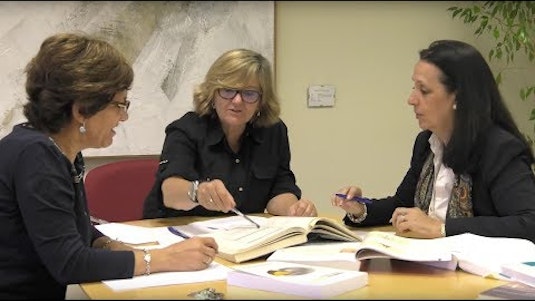
Moocable is learner-supported. When you buy through links on our site, we may earn an affiliate commission.
Description
Explore how algebra works and why it matters, and build a strong foundation of skills across many algebra topics including equations, rates, ratios, and sequences.
By the end of this course, you’ll know both traditional algebraic techniques and many unique problem-solving approaches that aren’t typically covered in school. You'll also improve your algebraic intuition and hone your strategic thinking for approaching difficult problems.
Tags
Syllabus
- Introduction: Supercharge your algebraic intuition and problem solving skills!
- Scale and Lever Logic: Warm up the skills and intuition that algebra requires by balancing scales and measuring weights.
- Magic Sum Puzzles: How can numbers be arranged so that these three specific sets all sum to 12?
- Sequences: Find and describe the patterns in these visual sequences.
- Simplifying Shortcuts: Save time with this clever thinking.
- Shortcuts 101: Learn some clever techniques to simplify problems, saving yourself time and effort.
- Guess, Check, and Revise: In this strategic shortcut, use an easy number as a test case and then update to find the true answer.
- Arithmetic Tricks I: These problems can be quickly solved in your head if you find the trick to each of them.
- Arithmetic Tricks II: Practice using rearrangement of terms, factoring, distribution, canceling, and any other tricks you know!
- Difference of Squares: Representing an algebraic identity geometrically can lead to deep insights.
- The Gauss Trick: 1 + 2 + 3 + 4 + 5 + 6 + 7 + 8 can be mentally evaluated faster than you might expect!
- Odd Square Sums: Manipulate these odd arrays of dots to find another useful summation shortcut.
- Pentagonal and Hexagonal Numbers: Extend the tricks from triangular and square numbers to the next two sets of polygonal numbers.
- Master of All Shortcuts: These problems require creative combinations of all the shortcuts that you've seen so far.
- Arithmetic Logic and Magic: Puzzles that are like Sudoku, but trickier!
- Magic Rectangles Part I: Is it possible to fill these grids so that the sums of the rows and columns are all correctly predicted?
- Magic Rectangles Part II: What if, instead of specific target sums, you only know that all of the sums need to match?
- Magic Perimeters: In this exploration, the digits need to be filled in around the perimeter of each shape.
- Learn Calcdoku: It's like Sudoku except that each specified region must obey a specific arithmetical rule.
- Beginner Calcdoku: Do this round of puzzles to get warmed up!
- Thinking About Calcdoku: Go a bit meta to explore some of the mathematics at work 'behind the scenes' of Calcdoku.
- More Advanced Calcdoku: Now you're prepared for some intense 4x4 Calcdoku challenges!
- Calcdoku 5x5: These are the most advanced Calcdoku puzzles in this unit — good luck!
- Balancing Scales: The unification of logic and algebra.
- Balancing Scales: Explore several types of balance puzzles and learn some strategies for approaching them.
- Elimination: Simplify systems combining the shapes that balance on one scale with those that balance on another.
- Substitution: First isolate a shape on one side of a scale, then use this equivalency to make substitutions elsewhere.
- Fraction-Related Strategies: When fractional shapes or numbers are involved, a few additional steps are required to isolate variables.
- More than Two Variables: Extend your thinking to cases where there are more, different unknowns in each puzzle.
- Balancing Chemical Equations: Apply what you've learned balancing scales to the scientific application of balancing chemical equations.
- Sequences: 2, 5, 10, 17, 26... What comes next?
- What Comes Next?: Explore, describe, and then predict the patterns in these sequences.
- Describing Sequences: Practice describing sequences in three different ways: by property, recursively, and explicitly.
- Arithmetic Sequences: Focus in on this one sequence type and learn a few tricks that take advantage of its steady behavior.
- Geometric Sequences: Now focus in on these sequences that evolve using recursive multiplication instead of addition.
- Geometric Applications: Apply what you know about geometric sequences to visualize the formation of fractal figures.
- Fibonacci and More: Solve challenging problems that employ recursively-described sequences such as the Fibonacci sequence.
- Rates and Ratios: If 4 cows make 4 gallons of milk in 4 days, how much milk do 8 cows make in 8 days?
- Applying Rates and Ratios: Explore rates and ratios in some of the real-life situations in which they show up.
- Proportionality: Hone your skills solving problems that employ proportionality and inverse proportionality.
- Joint Proportionality: In this exploration, multiple variables can change simultaneously, all contributing to an overall effect.
- Scaling 3D Shapes: Explore how scaling an object can counter-intuitively affect other properties of that object.
- Inverse Square Laws: Understand why quantities related by physical and geometric laws have non-linear relationships.
- Mixing Problems: Extend the rates and ratio strategies in this unit to solve a sequence of challenging mixing puzzles.

-
TypeOnline Courses
-
ProviderBrilliant
Explore how algebra works and why it matters, and build a strong foundation of skills across many algebra topics including equations, rates, ratios, and sequences.
By the end of this course, you’ll know both traditional algebraic techniques and many unique problem-solving approaches that aren’t typically covered in school. You'll also improve your algebraic intuition and hone your strategic thinking for approaching difficult problems.
By the end of this course, you’ll know both traditional algebraic techniques and many unique problem-solving approaches that aren’t typically covered in school. You'll also improve your algebraic intuition and hone your strategic thinking for approaching difficult problems.
- Introduction: Supercharge your algebraic intuition and problem solving skills!
- Scale and Lever Logic: Warm up the skills and intuition that algebra requires by balancing scales and measuring weights.
- Magic Sum Puzzles: How can numbers be arranged so that these three specific sets all sum to 12?
- Sequences: Find and describe the patterns in these visual sequences.
- Simplifying Shortcuts: Save time with this clever thinking.
- Shortcuts 101: Learn some clever techniques to simplify problems, saving yourself time and effort.
- Guess, Check, and Revise: In this strategic shortcut, use an easy number as a test case and then update to find the true answer.
- Arithmetic Tricks I: These problems can be quickly solved in your head if you find the trick to each of them.
- Arithmetic Tricks II: Practice using rearrangement of terms, factoring, distribution, canceling, and any other tricks you know!
- Difference of Squares: Representing an algebraic identity geometrically can lead to deep insights.
- The Gauss Trick: 1 + 2 + 3 + 4 + 5 + 6 + 7 + 8 can be mentally evaluated faster than you might expect!
- Odd Square Sums: Manipulate these odd arrays of dots to find another useful summation shortcut.
- Pentagonal and Hexagonal Numbers: Extend the tricks from triangular and square numbers to the next two sets of polygonal numbers.
- Master of All Shortcuts: These problems require creative combinations of all the shortcuts that you've seen so far.
- Arithmetic Logic and Magic: Puzzles that are like Sudoku, but trickier!
- Magic Rectangles Part I: Is it possible to fill these grids so that the sums of the rows and columns are all correctly predicted?
- Magic Rectangles Part II: What if, instead of specific target sums, you only know that all of the sums need to match?
- Magic Perimeters: In this exploration, the digits need to be filled in around the perimeter of each shape.
- Learn Calcdoku: It's like Sudoku except that each specified region must obey a specific arithmetical rule.
- Beginner Calcdoku: Do this round of puzzles to get warmed up!
- Thinking About Calcdoku: Go a bit meta to explore some of the mathematics at work 'behind the scenes' of Calcdoku.
- More Advanced Calcdoku: Now you're prepared for some intense 4x4 Calcdoku challenges!
- Calcdoku 5x5: These are the most advanced Calcdoku puzzles in this unit — good luck!
- Balancing Scales: The unification of logic and algebra.
- Balancing Scales: Explore several types of balance puzzles and learn some strategies for approaching them.
- Elimination: Simplify systems combining the shapes that balance on one scale with those that balance on another.
- Substitution: First isolate a shape on one side of a scale, then use this equivalency to make substitutions elsewhere.
- Fraction-Related Strategies: When fractional shapes or numbers are involved, a few additional steps are required to isolate variables.
- More than Two Variables: Extend your thinking to cases where there are more, different unknowns in each puzzle.
- Balancing Chemical Equations: Apply what you've learned balancing scales to the scientific application of balancing chemical equations.
- Sequences: 2, 5, 10, 17, 26... What comes next?
- What Comes Next?: Explore, describe, and then predict the patterns in these sequences.
- Describing Sequences: Practice describing sequences in three different ways: by property, recursively, and explicitly.
- Arithmetic Sequences: Focus in on this one sequence type and learn a few tricks that take advantage of its steady behavior.
- Geometric Sequences: Now focus in on these sequences that evolve using recursive multiplication instead of addition.
- Geometric Applications: Apply what you know about geometric sequences to visualize the formation of fractal figures.
- Fibonacci and More: Solve challenging problems that employ recursively-described sequences such as the Fibonacci sequence.
- Rates and Ratios: If 4 cows make 4 gallons of milk in 4 days, how much milk do 8 cows make in 8 days?
- Applying Rates and Ratios: Explore rates and ratios in some of the real-life situations in which they show up.
- Proportionality: Hone your skills solving problems that employ proportionality and inverse proportionality.
- Joint Proportionality: In this exploration, multiple variables can change simultaneously, all contributing to an overall effect.
- Scaling 3D Shapes: Explore how scaling an object can counter-intuitively affect other properties of that object.
- Inverse Square Laws: Understand why quantities related by physical and geometric laws have non-linear relationships.
- Mixing Problems: Extend the rates and ratio strategies in this unit to solve a sequence of challenging mixing puzzles.
Tags
Related Courses


Matemáticas y Estadística: entiéndelas, úsalas

คณิตศาสตร์เพื่อคอมพิวเตอร์ | Mathematics for Computer

Introduction to Differential Equations

PhETs - Interactive Simulations for Science and maths

College Algebra and Problem Solving

Math for Machine Learning (Indonesian)

Joy of Problem Solving

Casino Probability

MoGEA Mathematics Subtest (068): Practice & Study Guide

ISEE Lower Level: Practice & Study Guide

Introduction to Probability and Data - Labs
Loading...
Saving...
Loading...

 Online Courses
Online Courses  Brilliant
Brilliant
